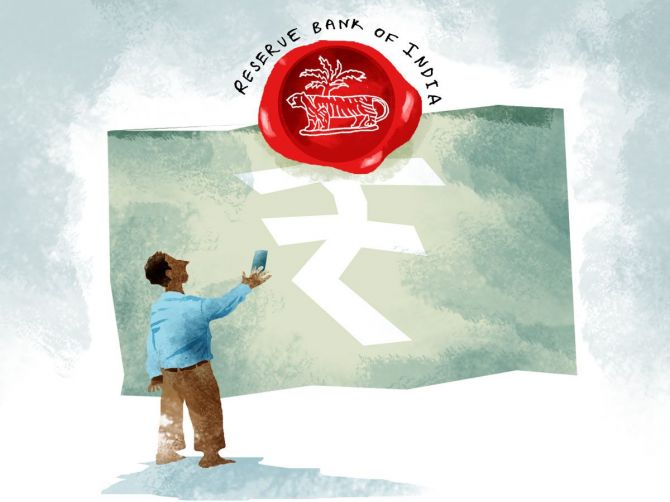For the time being, digital lending remains a grey area, notes Tamal Bandyopadhyay.

During a visit to Kolkata in December, I decided to drop by a bar with a few old friends.
A group of young men -- probably collegians, busy making merry with beer -- nearly spoiled our nostalgia trip in Job Charnock's city.
We were disturbed, but it didn't take me much time to strike a conversation with the group. The gentlemen visit the bar, where drinks are moderately priced, twice a month. None of them is working. They have been looking for jobs.
How do they get the money to come there so often? Well, it's not difficult. They borrow from a loan app. The amount could be as low as Rs 1,500.
They repay the loans with what they earn from giving tuitions or from their parents' coffers.
And most often, they pay off fast, much ahead of the repayment schedule. This helps them better their credit score.
A friend in Delhi says he has come across similar groups of young borrowers.
In Mumbai, I know a few (they work as maids and cooks at households) who borrow from loan apps to buy cake to celebrate their children's birthdays.
The loan amounts are small and the interest rate high -- anywhere between 30 per cent and 60 per cent, or even more.
Typically, this class of borrowers doesn't bother about the interest rate -- they look at the instalment (principal plus interest) and decide on biting the bullet if their cash flow allows them to repay.
For instance, a vegetable vendor who borrows Rs 2,000 in the morning to buy stuff from the wholesale market, and sells it in retail for Rs 3,000, happily pays Rs 20 for the Rs 2,000 loan to a moneylender in the evening.
At 1 per cent a day (actually, half a day), she ends up paying Rs 365 per cent annually!
Why does the vegetable vendor pay so much interest to the moneylender? It's elementary, my dear reader -- convenience.
The banking system doesn't give ultra-short loans. Besides, there are checks and balances for the credit worthiness of a prospective borrower.
Moneylenders don't get into all this; the money is there for the asking. For such loans, they are into a business of profit/revenue-sharing.
Digital loan apps are tech-savvy moneylenders. We can call the facility buy now, pay later (BNPL), pay-day loans (for salaried class), convenient loans or usurious loans.
Some of the apps cater to two different types of customers -- the unsecured personal loans of Rs 500 to Rs 5,000 to anybody and everybody at a very high interest rate, and Rs 5,000 to Rs 50,000 to salaried people (their pay cheques work as a collateral) at lower interest rates.
The hook for college students and people at the bottom of the pyramid is bringing them to the formal credit fold.
If they pay back on time, their credit score will rise and some day in the future, the banking system will find them worthy of giving loans.
A recent Financial Times report says almost 25 per cent of UK's BNPL users have been charged late repayment fees and the younger consumers have been hit the hardest.
Citing data from non-profit Centre for Financial Capability (CFC), it says 34 per cent of consumers in the age group of 18-24 were charged late fees, more than any other group.
About 22 per cent of BNPL users had missed one or two repayments in the second half of calendar 2023.
The report quoted CFC trustee Jane Goodland saying, 'As the ongoing cost of living crisis continues to impact the British public, it is apparent that many users are increasingly reliant on these schemes, without fully understanding the risks involved.'
The scene unfolding on the Indian financial turf is similar -- poor people and unemployed youth are borrowing consumption loans 'without fully understanding the risks'.
What can be done about it?
The Usurious Loans Act, 1918, talks about intervention of the court in such cases, but doesn't define what is predatory lending or usurious interest rate. Is it 30 per cent or 60 per cent, or more?
The Act empowers the courts to intervene in case the interest rate charged is excessive and the transaction is substantially unfair for the borrower. Clearly, everything depends on the context.
Also, this Act comes into force only for private loans. Banks and financial institutions are governed by the Reserve Bank of India norms.
Section 21A of the Banking Regulation Act says: 'Rates of interest charged by banking companies not to be subject to scrutiny by courts.
'Notwithstanding anything contained in the Usurious Loans Act... or any other law relating to indebtedness in force in any State, a transaction between a banking company and its debtor shall not be re-opened by any court on the ground that the rate of interest charged by the banking company in respect of such transaction is excessive.'
Incidentally, in August 2008, the National Consumer Disputes Redressal Commission had ruled that charging of interest at rates in excess of 30 per cent per annum on credit card loans is an unfair trade practice.
The banks promptly moved the Supreme Court and got a stay over it.
In the US, each state has a different approach to usury law and the maximum interest rate that a lender can charge varies from state to state.
Also, the caps are different for different loans.
For instance, in South Carolina, the maximum legal interest rate is 8.85 per cent, but for credit cards, it's 18 per cent.
In California, the maximum rate for consumer loans is 10 per cent.
However, banks and similar institutions are exempted from this. In Colorado, rates are capped at 45 per cent for non-consumer loans, while consumer loans are capped at 12 per cent.
In India, there was a cap on micro loans till March 2022. Such loan rates are market-driven now. For that matter, any loan rate is determined by market forces.
As far as loan apps are concerned, they are free to charge any interest rate as long as they provide the 'key facts' to the borrowers and in a transparent way disclose the annual percentage rate, which includes the cost of funds, credit cost (for loan defaults), operational cost, processing fee, verification and maintenance charges as well as the margin.
This essentially means that even when a lender is charging a very high interest rate, if it explains the cost of loan transparently and the borrower has no qualms about it, the RBI can't do anything. It's another matter that the borrowers are getting into a debt trap, 'without understanding the risks'.
This, of course, doesn't mean that the regulator is keeping its eyes closed.
It knows that some of the dormant non-banking financial companies are renting out their licence to loan apps.
Many lenders are 'outsourcing' loans through the digital entities for a 'management fee'.
An RBI working group on digital lending has recommended setting up an independent body -- DIGITA (Digital India Trust Agency) -- that will be responsible for verifying the technological credentials of the digital apps.
It has also recommended a separate legislation for illegal digital lending, Banning of Unregulated Lending Activities (BULA) Act, to cover all entities in this space that are not authorised by the central bank to lend to anyone.
Let's wait for this to happen. For the time being, digital lending remains a grey area.
PS: If you want a job in the banking sector, beyond academic qualifications, you need to have a healthy credit score. The Institute of Banking Personnel Selection wants the candidates seeking positions in banks to have a 'healthy credit history' and a minimum CIBIL score of 650 or above at the time of joining.
Tamal Bandyopadhyay, author of Roller Coaster: An Affair with Banking, is a senior advisor to the Jana Small Finance Bank Ltd.
Feature Presentation: Aslam Hunani/Rediff.com











